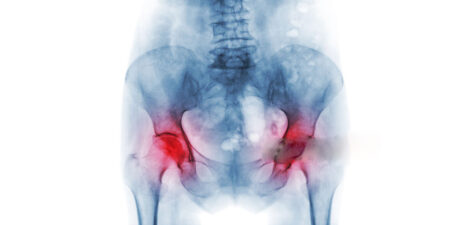Recently, several treatment recommendations for knee and hip osteoarthritis have been published with very different (mostly negative) statements on injection therapy for these joints, which sometimes make it difficult to provide practicing physicians with a proper “common thread”. The statements expressed in these articles are mainly based on meta-analyses or guidelines from various international societies.
However, if you take a look at the publications of recent years on the subject of autologous blood / platelet-rich plasma (PRP) injections, it is surprising that this type of therapy comes off so badly in the treatment recommendations. With the following article, I shall try to shed some light into this darkness and encourage you to think about the topic, above all for yourself.
The current issue of “Osteoarthritis and Cartilage” deals with joint-preserving treatment recommendations for knee and hip osteoarthritis. This study assessed the levels of recommendations from international professional societies and summarised their results. Twenty-five guidelines were included, seven of which were rated as “of higher quality”. In particular, the importance of exercise, weight management and patient education is emphasised. With regard to injection therapy, the guidelines recommend glucocorticoid injections for the knee joint. At the same time, however, the included recommendations advise against hyaluronic acid (HA) injections of the knee joint and PRP injections of the knee and hip joints [1]. In a recent issue of the German medical journal Deutsches Ärzteblatt, the topic is presented in a similar, albeit somewhat more differentiated, way. Here, glucocorticoids are recommended for short-acting pain control for refractory symptoms, but it is made clear that prolonged use increases the risk of cartilage loss and, subsequently, osteoarthritis progression. Based on the underlying guidelines, the evidence for the use of hyaluronic acid is rated as low, with the observation that high molecular weight hyaluronic acid could produce better results than low molecular weight hyaluronic acid. As regards injections with PRP, aspirates from bone marrow/adipose tissue or expanded mesenchymal stromal cells (MSC), the sources used to date do not provide any convincing evidence of longer-term therapeutic effects [2]. Unlike the two studies mentioned above, the European Society for Sports Traumatology, Knee Surgery and Arthroscopy (ESSKA) takes a very positive stance on the use and evidence of injectable orthobiologics in the treatment of osteoarthritis of the knee in its ORBIT (ORthoBiologics InitiaTive) Consensus 2022. They recommend PRP for knees with moderate osteoarthritis, consider PRP to be safer than glucocorticoids, especially with respect to the chondrotoxicity of cortisone, and favour PRP over HA. As far as the superiority of leukocyte-poor or leukocyte-rich PRP and the other differences between the individual PRP products are concerned, the ORBIT Group does not see sufficient scientific evidence to provide any recommendations. On the question of the number of injections, more than one is recommended [3].
Even though this is not a guideline or registered meta-analysis, it should be added that Jörg Jerosch, who unfortunately died far too early, also commented on injection therapy with cortisone, hyaluronic acid and PRP in one of his last review articles on the conservative treatment of osteoarthritis. He ascribes glucocorticoid injections a short-term positive effect in activated osteoarthritis of the knee but puts this into perspective by adding that hyaluronic acid injections are already superior after just eight weeks. With respect to the various HA preparations, he quotes that high molecular weight HAs show better clinical results than low molecular weight HAs. He gives a positive assessment of intraarticular PRP injections and refers exclusively to the above-mentioned ESSKA consensus paper [4].
PRP in the current literature
When looking at the recommendations given above [1, 2], it is somewhat surprising that the role of PRP in the treatment of knee and hip osteoarthritis in particular is presented so negatively, and that glucocorticoid injections are still recommended. The current literature actually takes a different view. Over recent months, various meta-analyses have appeared which report clearly positive results in the use of PRP in large patient groups. Xue et. al. summarise 16 randomised and controlled studies with a total of 1652 patients which favour PRP over all other injectable substances with respect to pain, stiffness and function [5]. Large meta-analyses involving 1805, 1292 and 1042 patients reached similar results [6 – 8].
PRP and HA in the current literature
The majority of current comparative studies favour PRP in comparison with HA. In a meta-analysis, Belk et al. compared 811 patients after PRP injections with 797 patients after HA injections [9]. The PRP group demonstrated a better result as compared with the HA group with respect to various clinical scores (WOMAC, VAS and IKDC). In the PRP group, the leukocyte-poor preparations showed significantly better results than the leukocyte-rich preparations. Another meta-analysis involving 1077 patients in the PRP group and 1009 patients in der HA group also reached similar results for the comparison between PRP and HA [10]. Current meta-analyses looking at the combination of PRP and HA are also very interesting. Thus, all available studies show no increased side effects rates for the combination of both preparations in comparison with single therapy with PRP or HA [11 – 13]. Interestingly, Zhang et. al even report that fewer side effects developed with combination therapy of PRP and HA than with single therapy with PRP. In terms of various clinical scores, the present meta-analyses show better results for a combination of PRP and HA in comparison with single therapy with PRP or HA [11 – 13].
The role of glucocorticoids
Here, too, a look at the current literature is somewhat surprising with respect to the statements made in the recommendations discussed at the beginning of this article [1, 2]. If PRP injections are compared directly with glucocorticoid injections, then significantly better results are found for patients after PRP injections [14]. Donavan et al. present similar results (also in “Osteoarthritis and Cartilage”), reporting that recurrent cortisone injections are clearly inferior to PRP or HA [15]. Even more decisive, however, is a look at various studies linking cortisone injections with an accelerated progression of osteoarthritis. For example, large groups of data from the „Osteoarthritis Initiative“ in the USA show that glucocorticoid injections are associated with an increased risk of needing a total knee replacement (TKR) in the course of the disease [16]. Another analysis of an even larger database shows very comparable results correlating dose-dependent intra-articular cortisone injections with an increased risk for knee replacement within the next five years [17].
Conclusion
If one looks at the current literature cited here (only sources from 2020 onwards), one gets the impression that the meta-analyses cited from the large patient groups shown do not necessarily correspond to the statements of the first two recently published treatment recommendations. PRP treatment, especially of osteoarthritis of the knee, certainly has a good and positive foundation in the literature. The combination of PRP and HA injections, in particular, appears to be a safe and promising combination therapy. The intra-articular injection of glucocorticoids should be reviewed and carries the risk of progression of cartilage damage.
——————————————
Note from the editorial team
In this respect, see also the articles in by Prof. Dr. Oliver Werz / Dr. Markus Werner „Glucocorticoids – New mechanisms of action decoded – timing counts in therapy“ and by Aranka Brockmüller and Prof. Dr. Mehdi Shakibaei „Epigenetic efficacy of curcumin as a therapeutic goal in osteoarthritis“ & „Resveratrol – A pearl of nature with prophylactic, therapeutic and regenerative potential“.
We would also like to draw your attention to further articles on osteoarthritis therapy, including those by Dr. Weisskopf, Prof. Dr. Jerosch and others, online on our sports medicine portal.
In line with this topic
Following a decision by the German Federal Administrative Court, natural health practitioners are not allowed to take blood from their patients to produce autologous blood products (Ref.No.: BVerwG 3 C 3.22, BVerwG 3 C 5.22 and BVerwG 3 C 4.22).
——————————————
References
- Gibbs AJ, Gray B, Wallis JA, et al. Recommendations for the management of hip and knee osteoarthritis: A systematic review of clinical practice guidelines. Osteoarthritis Cartilage 2023;31(10):1280-1292. DOI: 10.1016/j.joca.2023.05.015.
- Ossendorff R, Thimm D, Wirtz DC, Schildberg FA. Methods of Conservative Intra-Articular Treatment for Osteoarthritis of the Hip and Knee. Dtsch Arztebl Int 2023;120(35-36):575-581. DOI: 10.3238/arztebl.m2023.0154.
- Laura de Girolamo LL, Isabel Andia, Lars Blønd, Berte Bøe, Tomislav Cengic, Ignacio Dallo, Philippe Heuberer, Kaywan Izadpanah, Ladislav Kovacic, Koen Lagae, Laura Mangiavini, Jacques Menetrey, Stefan Mogos, Emmanuel Papakostas, Yiannis Pengas, Helder Pereira, Tim Spalding, Tomasz Piontek, Patricia Thoreux, Trifon Totlis, Kerem Tekin Ulku, Peter Verdonk, Yaniv Yonai, Stefano Zaffagnini ESSKA ORBIT Consensus Use of injectable orthobiologics for the treatment of knee osteoarthritis. ESSKA 2022.
- Jerosch J. Konservative Schmerztherapie bei der Arthrose. Orthopädische und Unfallchirurgische Praxis 2023;12:236-243.
- Xue Y, Wang X, Wang X, Huang L, Yao A, Xue Y. A comparative study of the efficacy of intra-articular injection of different drugs in the treatment of mild to moderate knee osteoarthritis: A network meta-analysis. Medicine (Baltimore) 2023;102(12):e33339. DOI: 10.1097/MD.0000000000033339.
- Simental-Mendia M, Ortega-Mata D, Tamez-Mata Y, Olivo CAA, Vilchez-Cavazos F. Comparison of the clinical effectiveness of activated and non-activated platelet-rich plasma in the treatment of knee osteoarthritis: a systematic review and meta-analysis. Clin Rheumatol 2023;42(5):1397-1408. DOI: 10.1007/s10067-022-06463-x.
- Cao Y, Luo J, Han S, et al. A model-based quantitative analysis of efficacy and associated factors of platelet rich plasma treatment for osteoarthritis. Int J Surg 2023;109(6):1742-1752. DOI: 10.1097/JS9.0000000000000337.
- Belk JW, Lim JJ, Keeter C, et al. Patients With Knee Osteoarthritis Who Receive Platelet-Rich Plasma or Bone Marrow Aspirate Concentrate Injections Have Better Outcomes Than Patients Who Receive Hyaluronic Acid: Systematic Review and Meta-analysis. Arthroscopy 2023;39(7):1714-1734. DOI: 10.1016/j.arthro.2023.03.001.
- Belk JW, Kraeutler MJ, Houck DA, Goodrich JA, Dragoo JL, McCarty EC. Platelet-Rich Plasma Versus Hyaluronic Acid for Knee Osteoarthritis: A Systematic Review and Meta-analysis of Randomized Controlled Trials. Am J Sports Med 2021;49(1):249-260. DOI: 10.1177/0363546520909397.
- Kim JH, Park YB, Ha CW. Are leukocyte-poor or multiple injections of platelet-rich plasma more effective than hyaluronic acid for knee osteoarthritis? A systematic review and meta-analysis of randomized controlled trials. Arch Orthop Trauma Surg 2023;143(7):3879-3897. DOI: 10.1007/s00402-022-04637-5.
- Zhang Q, Liu T, Gu Y, Gao Y, Ni J. Efficacy and safety of platelet-rich plasma combined with hyaluronic acid versus platelet-rich plasma alone for knee osteoarthritis: a systematic review and meta-analysis. Journal of orthopaedic surgery and research 2022;17(1):499. DOI: 10.1186/s13018-022-03398-6.
- Karasavvidis T, Totlis T, Gilat R, Cole BJ. Platelet-Rich Plasma Combined With Hyaluronic Acid Improves Pain and Function Compared With Hyaluronic Acid Alone in Knee Osteoarthritis: A Systematic Review and Meta-analysis. Arthroscopy 2021;37(4):1277-1287 e1. DOI: 10.1016/j.arthro.2020.11.052.
- Zhao J, Huang H, Liang G, Zeng LF, Yang W, Liu J. Effects and safety of the combination of platelet-rich plasma (PRP) and hyaluronic acid (HA) in the treatment of knee osteoarthritis: a systematic review and meta-analysis. BMC Musculoskelet Disord 2020;21(1):224. DOI: 10.1186/s12891-020-03262-w.
- McLarnon M, Heron N. Intra-articular platelet-rich plasma injections versus intra-articular corticosteroid injections for symptomatic management of knee osteoarthritis: systematic review and meta-analysis. BMC Musculoskelet Disord 2021;22(1):550. DOI: 10.1186/s12891-021-04308-3.
- Donovan RL, Edwards TA, Judge A, Blom AW, Kunutsor SK, Whitehouse MR. Effects of recurrent intra-articular corticosteroid injections for osteoarthritis at 3 months and beyond: a systematic review and meta-analysis in comparison to other injectables. Osteoarthritis Cartilage 2022;30(12):1658-1669. DOI: 10.1016/j.joca.2022.07.011.
- Wijn SRW, Rovers MM, van Tienen TG, Hannink G. Intra-articular corticosteroid injections increase the risk of requiring knee arthroplasty. The bone & joint journal 2020;102-B(5):586-592. DOI: 10.1302/0301-620X.102B5.BJJ-2019-1376.R1.
- Burnett RA, 3rd, Khalid S, DeBenedetti A, Terhune EB, Angotti ML, Della Valle CJ. Intra-articular corticosteroid injections are associated with a dose-dependent risk of total knee arthroplasty at 5 years. Knee Surg Sports Traumatol Arthrosc 2023;31(2):426-431. DOI: 10.1007/s00167-022-07017-z.
Autoren
ist Facharzt für Orthopädie und Unfallchirurgie und ärztlicher Leiter des UKE Athleticum am Universitätsklinikum Hamburg Eppendorf. Er hat seit 2021 eine Professur für Orthopädische Sportmedizin am UKE. Außerdem ist er leitender
Mannschaftsarzt der HSV Fußball AG. Sein klinischer Fokus liegt im Bereich der regenerativen Knorpeltherapie, der Behandlung von Sportverletzungen und Überlastungsschäden. Prof. Welsch ist wiss. Beirat der sportärztezeitung.


